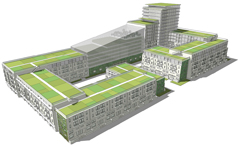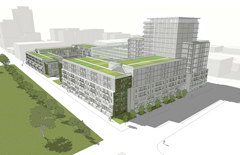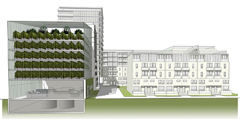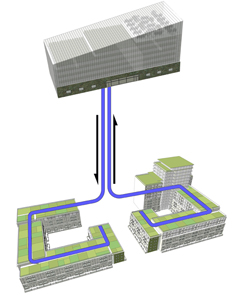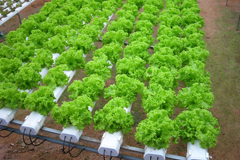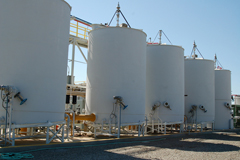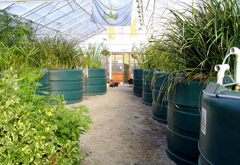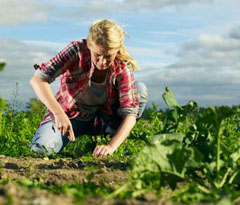Vertical Farm Arcology
Exhibit Category / Catégorie de l'expo: Housing
Location/Emplacement: Location Unspecified
Dates: 2009
Designers/Concepteurs: Gordon Graff
Clients: n/a
More Information/Plus d'informations: http://www.agro-arcology.com/
Image Credits/Crédits d'images: Gordon Graff
Project Description: (version française ci-dessous)
FOOD PRODUCTION
Food production is key to the VF Arcology concept. The primary producer is a 6 1/2 storey ‘vertical farm’, which is a compact hydroponic growing facility. The vertical farm produces enough food for 1,000 people year-round. In terms of tonnage grown, carrots, spinach, tomatoes, soybeans, and green peas are the primary produce. Chickens, bred for both meat and eggs, and tilapia are also easily accommodated within the tight confines. The roofs of VF Arcology are covered in 5,200 m2 of space available for community gardens. The elevated position ensures excellent light throughout the growing season, while compost supplied by the methane digester provides access to nutrient-rich soil. In addition to supplementing the food produced by the vertical farm, the gardens provide a source of exercise and a forum for social interaction. Food produced within the vertical farm, as well as any wishing to be sold by rooftop gardeners, can be obtained from the market located on the ground floor.
CYCLICAL METABOLISM
The Vertical Farm Arcology introduces the use of ‘producer’ components that enable on-site generation of food, power, and water, as well as on-site processing of waste water and biological waste. This is enabled by the use of three vital components: a living machine, a vertically oriented hydroponic farm, and a methane (or anaerobic) digester.
A living machine is a biological wastewater treatment system designed to mimic the natural water filtration of a wetland. In the VF Arcology, the living machine is designed to filter all water generated from the residential units and hydroponic farm. Though not quite potable, the purified water is ideal for use in the nutrient solution of the hydroponic farm - by far the largest water consumer on site - as well as all non-potable water uses for the residential units.
The hydroponic farm provides enough food for the 1,000 residents to live year-round, but it also provides more vital resources. Since most of the water consumed by plants is expelled as water vapour, dehumidifiers within the growing area can collect an abundant supply of potable water for residential use. Additionally, since plants consume carbon dioxide and expel oxygen, the vertical farm can produce fresh oxygenated air for the residential units, while their carbon dioxide rich waste air will enhance the growing conditions of the farm.
The methane digester consumes all biological wastes produced on site. This includes the kitchen scraps and human waste from the residential units, as well as the inedible plant material (leaves, stems) and animal waste (dung, carcases) from the vertical farm. In consumption of these wastes, the digester collects the methane released from the decomposing biological material and uses it to power a generator that produces electricity. Processing the biowaste of the vertical farm alone generates most of the energy requirements of the farm. Additional power can be obtained by collecting more biowaste, either in the form of compost from neighbouring buildings or by harvesting the solid waste from the city’s sewers.
Browse for more projects in the Carrot City Index.
Trouvez d’autres projets avec l’Index de Carrot City.


